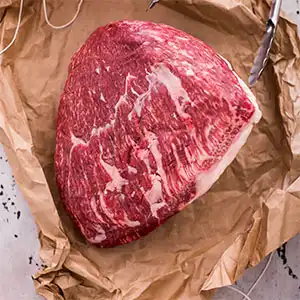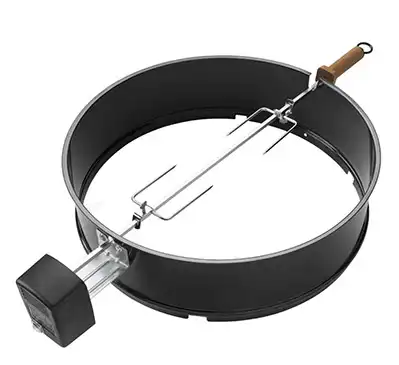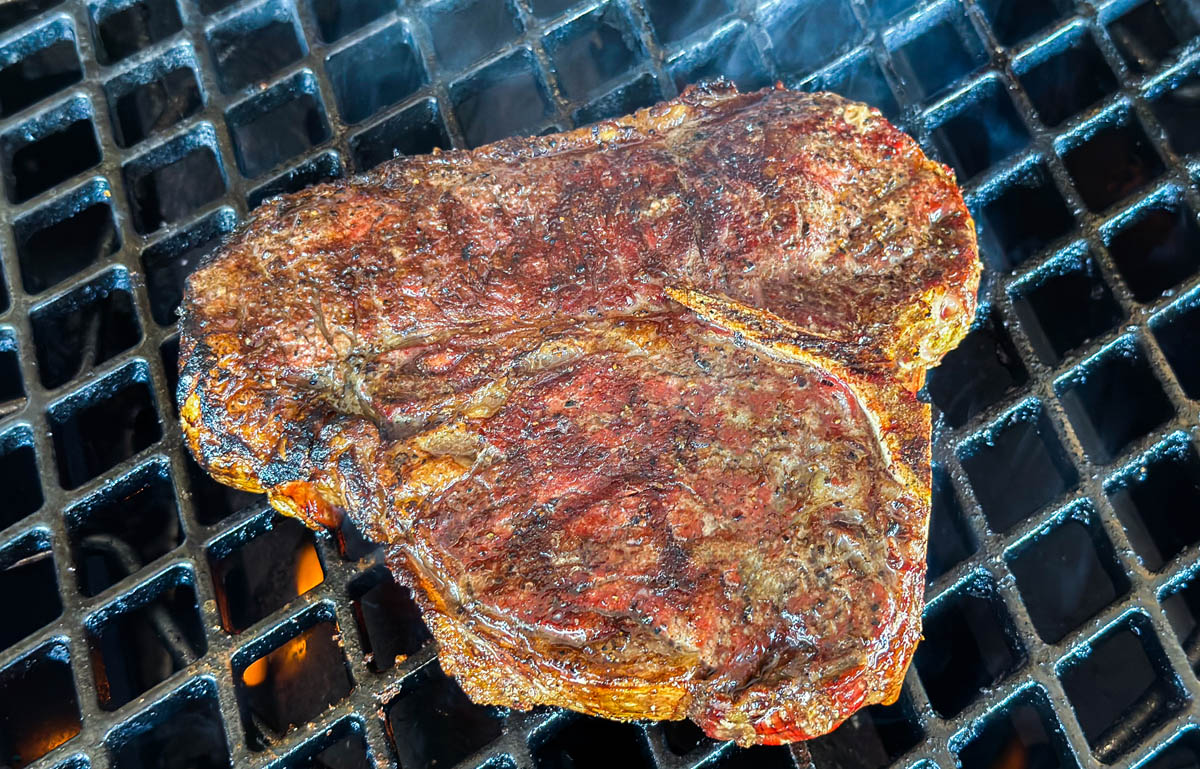Brazilian Picanha Steak With Chimichurri

One of my favorite things to cook directly over lump charcoal is Picanha.
You may know this cut as top sirloin cap, rump cover, rump cap, or coulotte.
No matter what you know it as it is super tasty and melt in your mouth beefy goodness if cooked correctly.
There are so many ways to serve this cut of beef up, sliced with chimichurri, as a beef Po’ Boy, or with some traditional Brazilian sides. I’m heading down the chimichurri path with this version.
Grilled picanha steak
There are traditionally three different ways to prep and cook picanha:
- Cook it whole indirectly away from the heat source, usually with a direct sear either before or after. We have a reverse sear picanha recipe you can check out for that.
- Cutting it into 1 to 1 ½ inch thick steaks and cook as you would a normal steak;
- Cut into thick 1 and ½ to 2-inch pieces, then skewer it onto a rotisserie and have it baste in its own juices as it turns over and over.
I think we all know which way I’m doing it. Read on for for detailed instructions, or watch the video recipe.
What you will need to make picanha
When you go to your butcher you want to make sure you ask for the fat cap left on. This is going to aid in the meat basting itself while slowly turning and cooking.
Try and get a good-sized rump cap around the 4.5 lbs or larger. This will allow you to fold the slices into horseshoe shapes to fit on the skewer. If the rump cap is small, it will make it very hard to fold the slices.

As always, get to know your butcher and tell them ahead of time what you need, this will always stop any disappointment down the track. Your butcher is only too willing to supply you with exactly what you want, so go have a chat with them.
If you don’t have a good butcher, the guys at Porter Road will sort you out with a high quality Picanha delivered to your door ready to cook.
Items that you’ll need to help make the cook easy are:
- Charcoal grill, I’m using a 22”
Weber Kettle . - I’m using a Weber Rotisserie attachment but any rotisserie will do the job.
- Good quality lump charcoal.
- A good quality internal thermometer.
- A boning or trimming knife.
- A butcher block or cutting board with juice crevices.
- A food processor (not 100% necessary, just makes things easier).
- And all the assorted ingredients to make chimichurri listed below in the full recipe.
Prepping the picanha
Firstly we need to trim off any silver skin if there is any. This will never render down and it is always best to remove it, as it doesn’t eat well.
We do not need to trim the fat cap, as the fat will start to render down a little during the cook and as it does those beefy fat juices will slowly keep basting the picanha throughout the entire cook.
If you aren’t salivating by now like me, I have no idea how to make you hungry.

Next, we need to cut the picanha in 1½ to 2 inch thick pieces with the grain.
We ideally want 3 to 4 pieces to skewer onto our rotisserie.
Cut the meat with the grain because unlike in Brazil, we won’t be slicing this directly off the skewer. I’ll be removing it to rest and then slicing the picanha across the grain.

If we were cooking the picanha as steaks, our first cut would also be with the grain, so when we are slicing it to eat after cooking, our final cut would also be against the grain.
Since rump cap has such a strong beef flavor, it really only needs Kosher salt to season it before cooking. This not only enhances the beef natural flavor but helps dry out the outer edges creating a nice bark or crust.
This crusty outer texture paired with the soft delicate juicy inner meat once served is one of life’s little pleasures.

Like with any seasoning, allow the salt to sit on the meat for at least 30 minutes prior to cooking.
Setting up your rotisserie
Picanha is a perfect cut for the rotisserie. The meat slowly spins while the high heat helps renders down some of the fat cap, resulting in one of the best beef flavors you’ll ever put in your mouth.
I’m going to be using lump charcoal for this cook and utilizing a 22”
If you already have a
I’ll be setting up to start the cook at high indirect heat of around 400°F by pushing two charcoal baskets filled with lit lump charcoal, to either side of the charcoal grate, with an empty tray in between to catch any juices.
With the rotisserie skewer placed directly above and in between the baskets, there will be enough heat to start the cooking process and allow some of the fat cap to render down.

If you place the meat directly over the heat source, you’ll constantly be battling fat flare-ups, due to the amount of fat that is going to render down from the fat cap.
I’m also going to be using some cherry wood to add a little more depth of flavor and a nice lick of smokiness and color to the final product.
I’m aiming to cook the picanha to a perfect medium rare, so aim for an internal temperature of 125°F, then remove from the heat and rest for 10 minutes.
The internal temperature will keep climbing and it should get to 130°F – 135°F. Keep an eye on it as cooking at high indirect heat, it will take about an hour to get to the desired internal temperature of 125°F.

While resting the meat, just loosely place some aluminum foil over the top of the meat, this is called tenting. It allows steam that builds up, to still escape while keeping in the heat.
If you aren’t making the chimichurri skip ahead to learn how to slice the picanha, but you really should be making the chimichurri…
Making the chimichurri
Pairing picanha with a nice spicy herbal chimichurri is a no brainer in my book.
Once you take that first mouthful of slightly charred but delicate beef added with the flavor bomb of the chimichurri and they explode in that first bite, you’ll be wondering why you haven’t been cooking this for years.
Less drooling, more making….
We need to put the garlic cloves, olive oil and bay leaves into a food processor and pulse until the garlic is finely minced throughout the oil.
Then we need to wash and dry the fresh herbs and onions and roughly chop them and then add these to the mixture and pulse again until they are mixed.
Careful not to take it too far! You want some texture in there, you are not making a puree. You want to see some pieces of herbs still in the mixture.

This chimichurri uses cilantro, now I know some people have an actually genetic disorder that can make this herb taste like soap, so you can substitute it for basil but this will obviously change the overall taste of the chimichurri.
Using a spatula, scrape out the mixture into a bowl and add the dry herbs and spices and stir them to mix thoroughly.

While constantly whisking the mixture, slowly add the red wine vinegar and you’ll be left with a thick herbal vinaigrette that leaves a nice sharp sensory overload in the nostrils.
Put this aside to allow the flavors to fully combine and intensify.
Time to get the picanha off the heat
This is the part of every cook I love. The work is done, everything you have prepped for is about to come together and tantalise the tastebuds, whether it be family or friends, you know you are about to make a lot of people very happy.
Take the rotisserie skewer off the heat. Remember this is going to be hot, so I suggest using some heatproof gloves here.
We need to rest the meat on a chopping board, make sure it has a juice crevice around the boarder to catch any overspilling juices. Loosely tent this with some aluminium foil for ten minutes.

While you are waiting for the picanha to rest, is a great time to prep a couple of last-minute things. I tend to give the chimichurri a stir, just to activate all those ingredients and because I love the smell of it.
Now grab a nice crusty baguette and slice diagonally into about ½ inch thick slices, this is a great way to serve the picanha and chimichurri.
Slice it up, across the grain.
It’s time to slice up the picanha. You will need a sharp knife to do this.
Always slice across the grain.
There are way too many people throwing out confusing information when it comes to slicing picanha, mainly because you slice it first to cook, then slice again once it is finished. As long as the final cut is against the grain, this is all you have to worry about.

I like to slice picanha between ¼ and ½ inch thick slices, laying them out on a serving platter or tray, season with salt flakes and drizzle with the chimichurri.
I do suggest doing it as quickly as possible, once the smells hit your guests noses, that sensory overload may result in a stampede and you could lose a finger.

Grab a slice of freshly baked crispy baguette, top with a slice or two of picanha and drizzle with chimichurri. I suggest grabbing a few on a plate, a cold beer or two and find a nice quiet place to enjoy them, you deserve it.
Related Recipes – Grilled Carne Asada

Brazilian Picanha Steak With Chimichurri
Ingredients
Picanha
- 4.5 lbs Rump cap or top sirloin
- Course sea salt for seasoning (before cooking)
- Salt Flakes for seasoning (after cooking)
Chimichurri
- ⅓ cup olive oil extra virgin
- 4 cloves garlic chopped
- 2 fresh bay leaves chopped
- 3 green onions chopped
- ¾ cup fresh parsley chopped
- 2 tbsp cilantro finely chopped, use basil if you prefer
- 1 tbsp dried oregano
- 1 tsp paprika
- 1 tbsp fresh red chili finely chopped
- 1 tsp coarse sea salt
- ½ tsp black pepper freshly ground
- ¼ cup red wine vinegar
Baguette
- 1 baguette thinly sliced into ½ inch diagonal pieces
Instructions
For the picanha
- Set up you rotisserie and grill for high indirect heat of around 400°F. I’m using a 22” Weber Kettle with a rotisserie attachment. So I’ll start by lighting a chimney full of good quality lump charcoal and once it is fully lit, I’ll distribute that evenly between two charcoal baskets. I’ll then push them to either side of the charcoal grate. Then I’ll add a drip pan for any fat runoff between the two charcoal baskets.
- Add a chunk of cherry wood on one of the baskets of lit charcoal. Any good smoke wood will work.
- Trim any silver skin off the rump cap, then slicing with the grain, cut the rump cap into 1 ½ to 2 inch thick slices.
- Carefully skewer them onto the rotisserie, folding each piece to look like a horse shoe.
- Then apply a liberal amount of course sea salt and set aside for at least 30 minutes.
- Place picanha into the grill and put the lid on, with all the vents wide open.
- Once the internal temperature reaches 125°F, (use an instant read thermometer to check) take the meat off the heat, remove from the skewer and loosely tent under some aluminium foil and allow the meat to rest for 10 minutes.
- After 10 minutes, the internal temperature should have risen to 130°F to 135°F. Now it’s time to slice across the grain in ¼ to ½ inch thick slices and layout on a serving platter or board.
Making the chimichurri
- Place the garlic cloves, olive oil and bay leaves into a food processor and pulse until the garlic has become a finely minced throughout the oil.
- Add the onions and pulse, but not to make the mixture a puree, just enough to chop all ingredients. You should still see pieces of onion in there.
- Using a spatula, scrape out the mixture into a bowl and add the chopped fresh and dry herbs and spices and stir them to mix all thoroughly.
- Now while whisking the mixture, slowly add the red wine vinegar and you’ll be left with a thick herbal vinaigrette that leaves a nice sharp sensory overload in the nostrils.
- Put this aside to allow the flavours to fully combine.
To serve
- Slice up a large baguette diagonally into ½ slices.
- Lay picanha out on a serving plater.
- Stir the chimichurri mix up and drizzle over the picanha slices.
- Place one or two slices of picanha onto a piece of baguette, drizzle some extra chimichurri over the top and enjoy.











